Effects of Maternal Exposure to Decamethylcyclopentasiloxane on the Alternations in Offspring Behaviors in Mice
Abstract
1. Introduction
2. Materials and Methods
2.1. Developmental Neurotoxicity Test (DNT)
2.2. Animals
2.3. Chemical Treatments
2.4. Behavior Tests
2.4.1. Grooming Test
2.4.2. Marble-Burying Test
2.4.3. Three-Chamber Test
2.4.4. Social Interaction Test
2.4.5. Tail Suspension Test
2.4.6. Forced Swimming Test
2.4.7. Novel Object Recognition Test
2.4.8. Morris Water Maze Test
2.5. Data Analysis
3. Results
3.1. D5 Is a Developmental Neurotoxicant
3.2. Maternal D5 Exposure Induced Abnormal Behavior in Offspring Mice
3.2.1. D5 Induced Repetitive Activity
3.2.2. D5 Induced Depression-like Behavior
3.2.3. D5 Impaired Sociality in Offspring Mice
3.2.4. D5 Impaired Memory and Learning Ability
4. Discussion
Author Contributions
Funding
Institutional Review Board Statement
Informed Consent Statement
Data Availability Statement
Conflicts of Interest
References
- Scientific Committee on Consumer Safety. Opinion of the Scientific Committee on Consumer Safety (SCCS)—Final version of the opinion on decamethylcyclopentasiloxane (cyclopentasiloxane, D5) in cosmetic products. Regul. Toxicol. Pharmacol. 2017, 83, 117–118. [Google Scholar] [CrossRef] [PubMed]
- ENVIRON International Corporation. Evaluation of Exposure to Decamethylcyclopentasiloxane (D5) for Consumers, Workers, and the General Public; Silicone Environmental Health and Safety Council, Global Silicones Council: Washington, WA, USA, 2006. [Google Scholar]
- Environment Canada, Health Canada. Screening Assessment for The Challenge Decamethylcyclopentasiloxane; Government of Canada: Ottawa, IL, Canada, 2008.
- Kim, M.E.; Park, H.R.; Gong, E.J.; Choi, S.Y.; Kim, H.S.; Lee, J. Exposure to bisphenol A appears to impair hippocampal neurogenesis and spatial learning and memory. Food Chem. Toxicol. 2011, 49, 3383–3389. [Google Scholar] [CrossRef] [PubMed]
- Lee, H.R.; Kim, T.H.; Choi, K.C. Functions and physiological roles of two types of estrogen receptors, ERalpha and ERbeta, identified by estrogen receptor knockout mouse. Lab. Anim. Res. 2012, 28, 71–76. [Google Scholar] [CrossRef] [PubMed]
- Mari-Bauset, S.; Donat-Vargas, C.; Llópis-González, A.; Marí-Sanchis, A.; Peraita-Costa, I.; Llopis-Morales, J.; Morales-Suárez-Varela, M. Endocrine Disruptors and Autism Spectrum Disorder in Pregnancy: A Review and Evaluation of the Quality of the Epidemiological Evidence. Children 2018, 5, 157. [Google Scholar] [CrossRef]
- Zarean, M.; Poursafa, P. The Role of Environmental Disruptor Chemicals in the Development of Non Communicable Disease. Adv. Exp. Med. Biol. 2019, 1121, 21–31. [Google Scholar] [CrossRef]
- Farag, A.T.; El Okazy, A.M.; El-Aswed, A.F. Developmental toxicity study of chlorpyrifos in rats. Reprod. Toxicol. 2003, 17, 203–208. [Google Scholar] [CrossRef]
- Murray, T.J.; Lea, R.G.; Abramovich, D.R.; Haites, N.E.; Fowler, P.A. Endocrine disrupting chemicals: Effects on human male reproductive health. Early Pregnancy 2001, 5, 80–112. [Google Scholar]
- Petro, E.M.; Leroy, J.L.; Covaci, A.; Fransen, E.; De Neubourg, D.; Dirtu, A.C.; De Pauw, I.; Bols, P.E. Endocrine-disrupting chemicals in human follicular fluid impair in vitro oocyte developmental competence. Hum. Reprod. 2012, 27, 1025–1033. [Google Scholar] [CrossRef]
- Wang, Y.; Zhang, W.; Li, A.; Song, M. Tetrachlorobisphenol A induced immunosuppression and uterine injury in mice. Ecotoxicol Environ. Saf. 2021, 207, 111527. [Google Scholar] [CrossRef]
- Pirozzi, C.; Lama, A.; Annunziata, C.; Cavaliere, G.; Ruiz-Fernandez, C.; Monnolo, A.; Comella, F.; Gualillo, O.; Stornaiuolo, M.; Mollica, M.P.; et al. Oral Bisphenol A Worsens Liver Immune-Metabolic and Mitochondrial Dysfunction Induced by High-Fat Diet in Adult Mice: Cross-Talk between Oxidative Stress and Inflammasome Pathway. Antioxidants 2020, 9, 1201. [Google Scholar] [CrossRef]
- Braun, J.M.; Kalkbrenner, A.E.; Just, A.C.; Yolton, K.; Calafat, A.M.; Sjodin, A.; Hauser, R.; Webster, G.M.; Chen, A.; Lanphear, B.P. Gestational exposure to endocrine-disrupting chemicals and reciprocal social, repetitive, and stereotypic behaviors in 4- and 5-year-old children: The HOME study. Environ. Health Perspect. 2014, 122, 513–520. [Google Scholar] [CrossRef] [PubMed]
- Jang, Y.J.; Park, H.R.; Kim, T.H.; Yang, W.J.; Lee, J.J.; Choi, S.Y.; Oh, S.B.; Lee, E.; Park, J.H.; Kim, H.P.; et al. High dose bisphenol A impairs hippocampal neurogenesis in female mice across generations. Toxicology 2012, 296, 73–82. [Google Scholar] [CrossRef] [PubMed]
- Lee, D.; Ahn, C.; An, B.S.; Jeung, E.B. Induction of the Estrogenic Marker Calbindn-D(9)k by Octamethylcyclotetrasiloxane. Int. J. Environ. Res. Public Health 2015, 12, 14610–14625. [Google Scholar] [CrossRef] [PubMed]
- Tran, D.N.; Park, S.-M.; Jung, E.-M.; Jeung, E.-B. Prenatal Octamethylcyclotetrasiloxane Exposure Impaired Proliferation of Neuronal Progenitor, Leading to Motor, Cognition, Social and Behavioral Functions. Int. J. Mol. Sci. 2021, 22, 12949. [Google Scholar] [CrossRef] [PubMed]
- Jean, P.A.; Sloter, E.D.; Plotzke, K.P. Effects of chronic exposure to octamethylcyclotetrasiloxane and decamethylcyclopentasiloxane in the aging female Fischer 344 rat. Toxicol. Lett. 2017, 279 (Suppl. 1), 54–74. [Google Scholar] [CrossRef]
- Dekant, W.; Klaunig, J.E. Toxicology of decamethylcyclopentasiloxane (D5). Regul. Toxicol. Pharmacol. 2016, 74, S67–S76. [Google Scholar] [CrossRef]
- Park, S.M.; Jo, N.R.; Lee, B.; Jung, E.M.; Lee, S.D.; Jeung, E.B. Establishment of a developmental neurotoxicity test by Sox1-GFP mouse embryonic stem cells. Reprod. Toxicol. 2021, 104, 96–105. [Google Scholar] [CrossRef]
- Jovanovic, M.L.; McMahon, J.M.; McNett, D.A.; Tobin, J.M.; Plotzke, K.P. In vitro and in vivo percutaneous absorption of 14C-octamethylcyclotetrasiloxane (14C-D4) and 14C-decamethylcyclopentasiloxane (14C-D5). Regul. Toxicol. Pharmacol. 2008, 50, 239–248. [Google Scholar] [CrossRef]
- Klaunig, J.E.; Dekant, W.; Plotzke, K.; Scialli, A.R. Biological relevance of decamethylcyclopentasiloxane (D5) induced rat uterine endometrial adenocarcinoma tumorigenesis: Mode of action and relevance to humans. Regul. Toxicol. Pharmacol. 2016, 74, S44–S56. [Google Scholar] [CrossRef]
- Siddiqui, W.H.; Stump, D.G.; Reynolds, V.L.; Plotzke, K.P.; Holson, J.F.; Meeks, R.G. A two-generation reproductive toxicity study of decamethylcyclopentasiloxane (D5) in rats exposed by whole-body vapor inhalation. Reprod. Toxicol. 2007, 23, 216–225. [Google Scholar] [CrossRef]
- Decamethylcyclopentasiloxane (D5). Toxicol. Ind. Health 2017, 33, 16–27. [CrossRef] [PubMed]
- Kazdoba, T.M.; Leach, P.T.; Crawley, J.N. Behavioral phenotypes of genetic mouse models of autism. Genes Brain Behav. 2016, 15, 7–26. [Google Scholar] [CrossRef]
- McTighe, S.M.; Neal, S.J.; Lin, Q.; Hughes, Z.A.; Smith, D.G. The BTBR mouse model of autism spectrum disorders has learning and attentional impairments and alterations in acetylcholine and kynurenic acid in prefrontal cortex. PLoS ONE 2013, 8, e62189. [Google Scholar] [CrossRef]
- Ishido, M.; Masuo, Y.; Kunimoto, M.; Oka, S.; Morita, M. Bisphenol A causes hyperactivity in the rat concomitantly with impairment of tyrosine hydroxylase immunoreactivity. J. Neurosci. Res. 2004, 76, 423–433. [Google Scholar] [CrossRef] [PubMed]
- Schalbroeck, R.; van Velden, F.H.P.; de Geus-Oei, L.F.; Yaqub, M.; van Amelsvoort, T.; Booij, J.; Selten, J.P. Striatal dopamine synthesis capacity in autism spectrum disorder and its relation with social defeat: An [(18)F]-FDOPA PET/CT study. Transl. Psychiatry 2021, 11, 47. [Google Scholar] [CrossRef]
- Palanza, P.L.; Howdeshell, K.L.; Parmigiani, S.; vom Saal, F.S. Exposure to a low dose of bisphenol A during fetal life or in adulthood alters maternal behavior in mice. Environ. Health Perspect. 2002, 110 (Suppl. 3), 415–422. [Google Scholar] [CrossRef] [PubMed]
- Wang, Z.; Alderman, M.H.; Asgari, C.; Taylor, H.S. Fetal Bisphenol-A Induced Changes in Murine Behavior and Brain Gene Expression Persisted in Adult-aged Offspring. Endocrinology 2020, 161, bqaa164. [Google Scholar] [CrossRef] [PubMed]
- Vandenderg, L.N. Non-Monotonic Dose Responses in Studies of Endocrine Disrupting Chemicals_ Bisphenol a as a Case Study. Int. Dose-Reposesoc. 2014, 12, 259. [Google Scholar]
- Clotfelter, E.D.; Bell, A.M.; Levering, K.R. The role of animal behaviour in the study of endocrine-disrupting chemicals. Anim. Behav. 2004, 68, 665–676. [Google Scholar] [CrossRef]
- Tian, Y.H.; Baek, J.H.; Lee, S.Y.; Jang, C.G. Prenatal and postnatal exposure to bisphenol a induces anxiolytic behaviors and cognitive deficits in mice. Synapse 2010, 64, 432–439. [Google Scholar] [CrossRef] [PubMed]
- Ricceri, L.; Venerosi, A.; Capone, F.; Cometa, M.F.; Lorenzini, P.; Fortuna, S.; Calamandrei, G. Developmental neurotoxicity of organophosphorous pesticides: Fetal and neonatal exposure to chlorpyrifos alters sex-specific behaviors at adulthood in mice. Toxicol. Sci. 2006, 93, 105–113. [Google Scholar] [CrossRef] [PubMed]
- Chen, J.; Chen, Y.; Liu, W.; Bai, C.; Liu, X.; Liu, K.; Li, R.; Zhu, J.H.; Huang, C. Developmental lead acetate exposure induces embryonic toxicity and memory deficit in adult zebrafish. Neurotoxicol. Teratol. 2012, 34, 581–586. [Google Scholar] [CrossRef] [PubMed]
- Hernandez-Coro, A.; Sanchez-Hernandez, B.E.; Montes, S.; Martinez-Lazcano, J.C.; Gonzalez-Guevara, E.; Perez-Severiano, F. Alterations in gene expression due to chronic lead exposure induce behavioral changes. Neurosci. Biobehav. Rev. 2021, 126, 361–367. [Google Scholar] [CrossRef] [PubMed]
- Grabovska, S.; Salyha, Y. ADHD-like behaviour in the offspring of female rats exposed to low chlorpyrifos doses before pregnancy. Arh. Hig. Rada Toksikol. 2015, 66, 121–127. [Google Scholar] [CrossRef] [PubMed][Green Version]
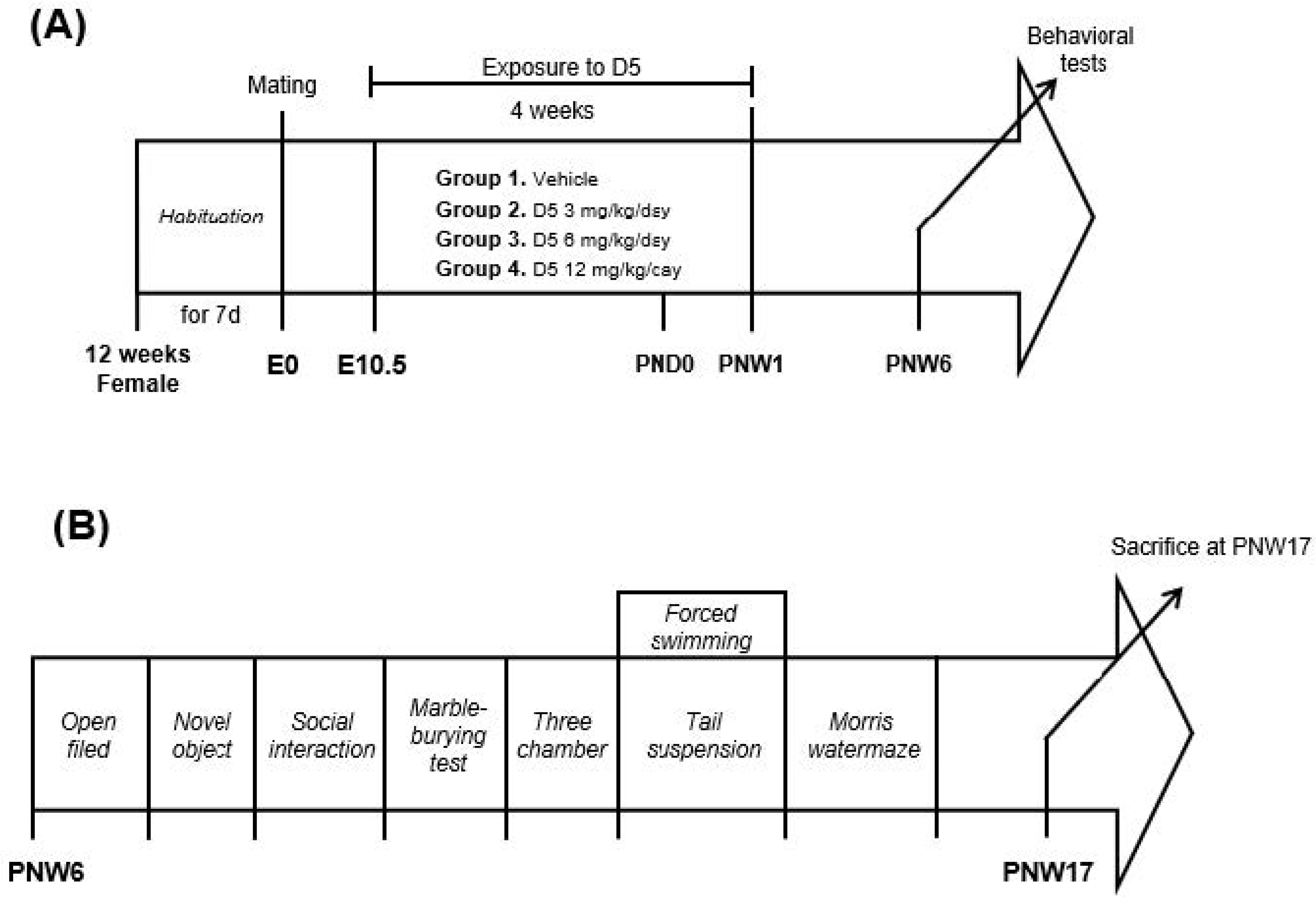
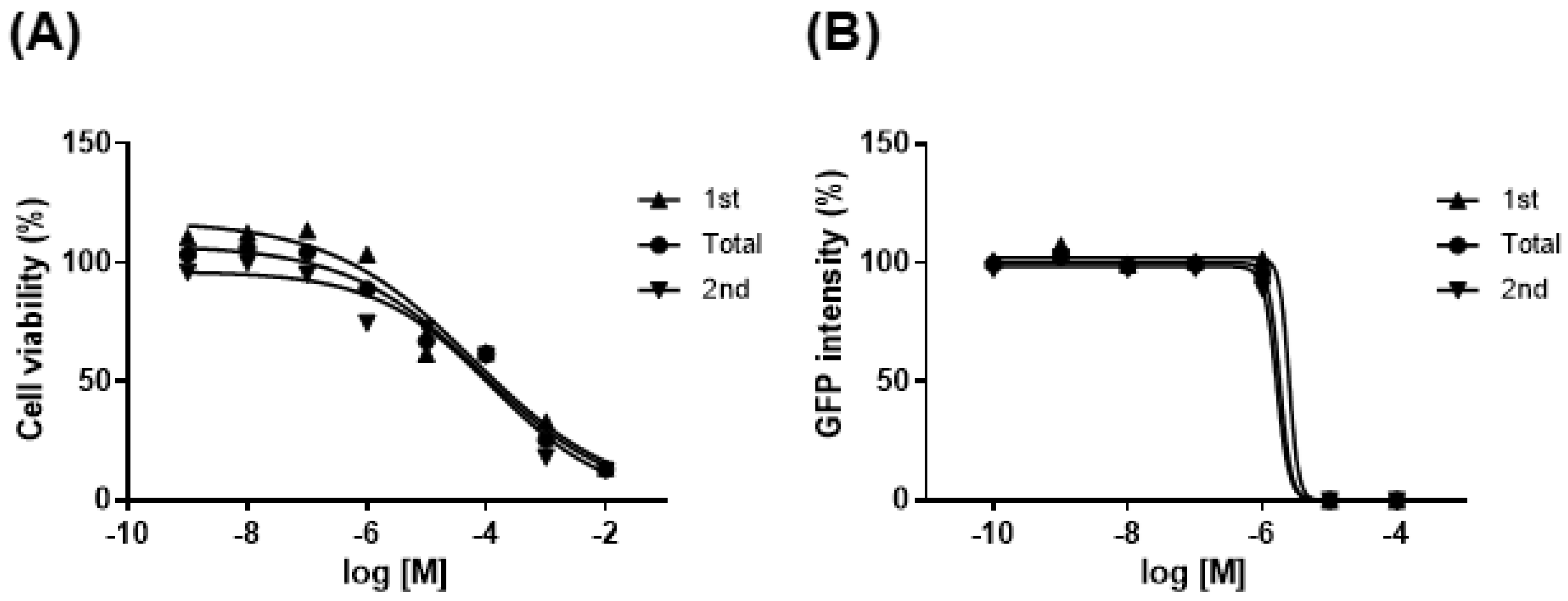


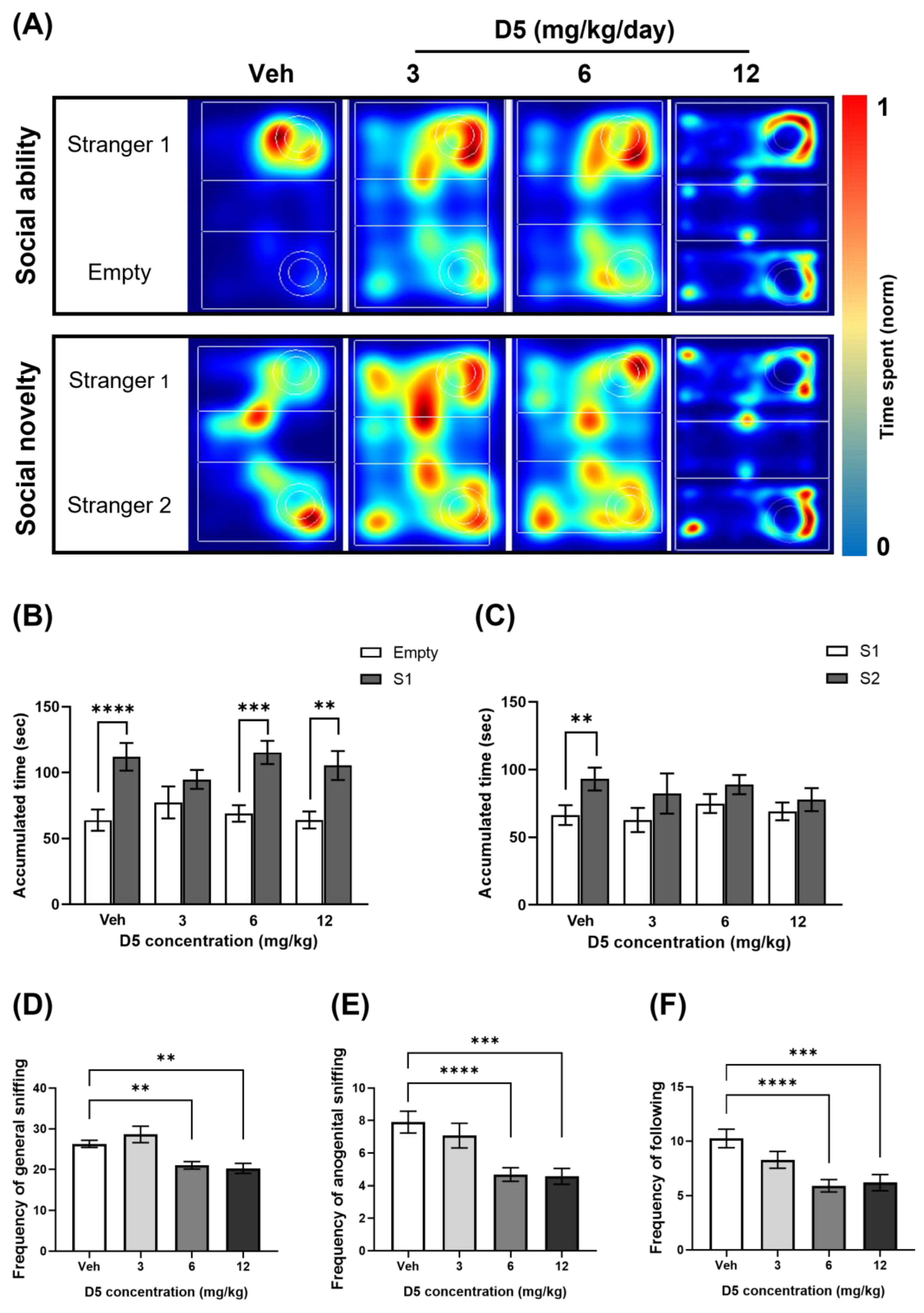
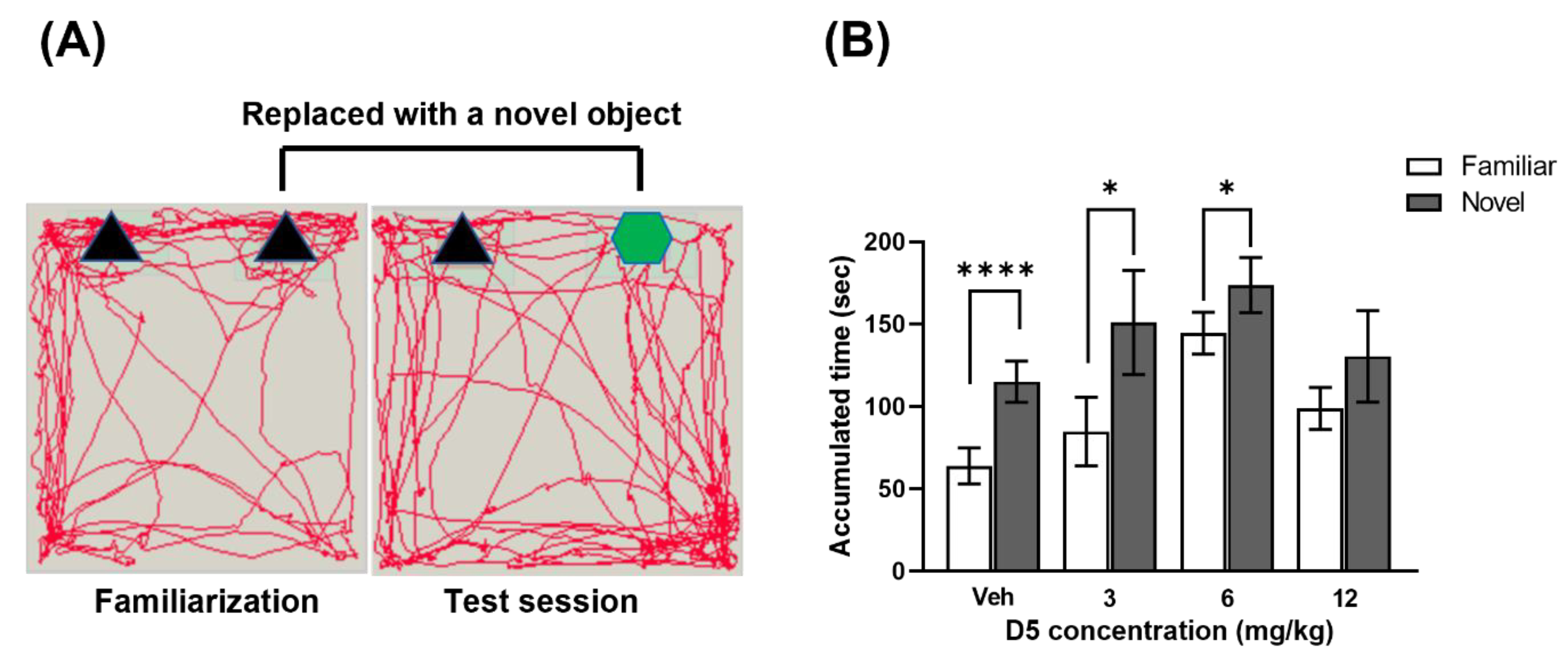
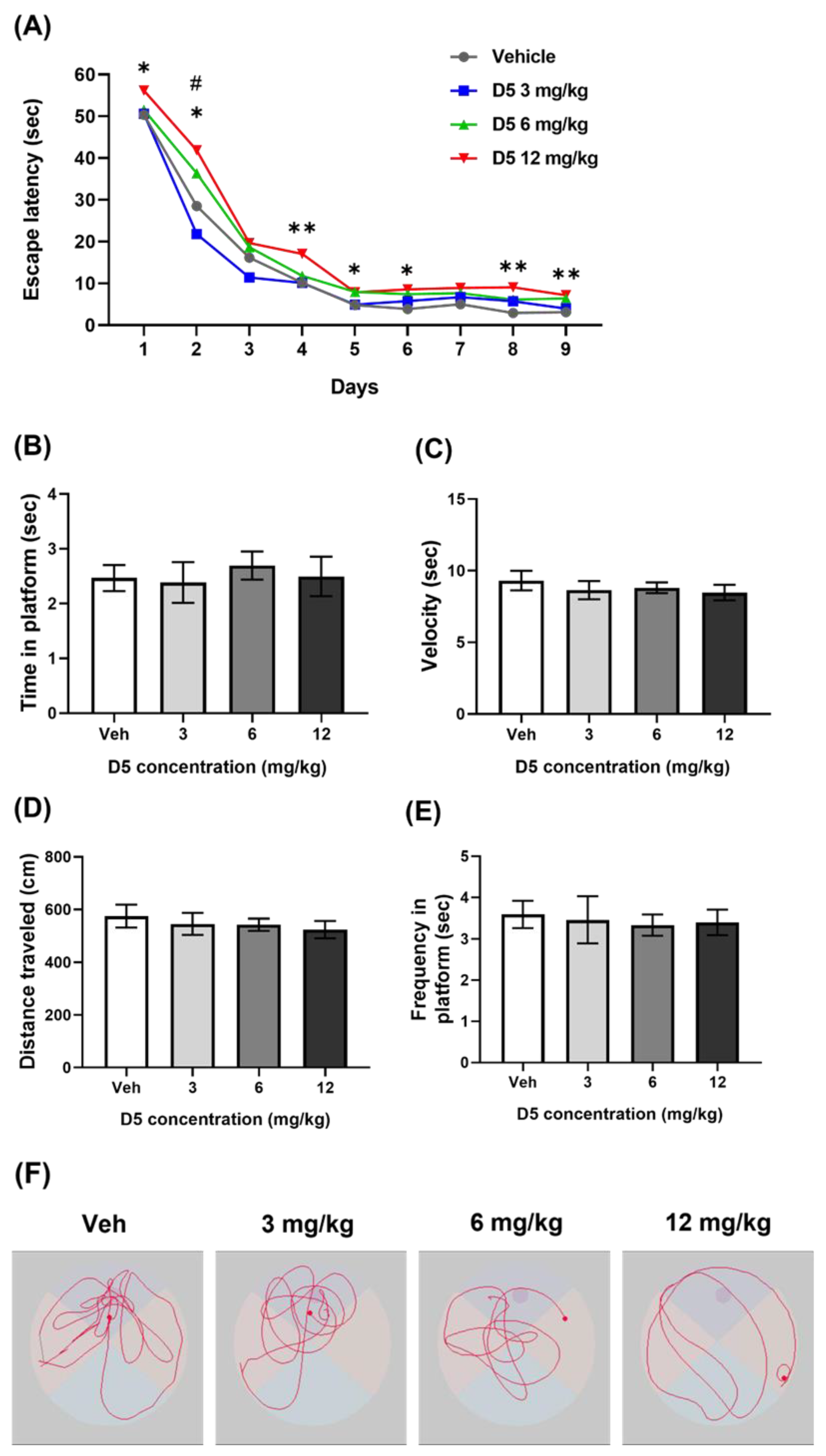
Disclaimer/Publisher’s Note: The statements, opinions and data contained in all publications are solely those of the individual author(s) and contributor(s) and not of MDPI and/or the editor(s). MDPI and/or the editor(s) disclaim responsibility for any injury to people or property resulting from any ideas, methods, instructions or products referred to in the content. |
© 2022 by the authors. Licensee MDPI, Basel, Switzerland. This article is an open access article distributed under the terms and conditions of the Creative Commons Attribution (CC BY) license (https://creativecommons.org/licenses/by/4.0/).
Share and Cite
Yi, D.; Kim, K.; Lee, M.; Jung, E.-m.; Jeung, E.-B. Effects of Maternal Exposure to Decamethylcyclopentasiloxane on the Alternations in Offspring Behaviors in Mice. Biomedicines 2023, 11, 35. https://doi.org/10.3390/biomedicines11010035
Yi D, Kim K, Lee M, Jung E-m, Jeung E-B. Effects of Maternal Exposure to Decamethylcyclopentasiloxane on the Alternations in Offspring Behaviors in Mice. Biomedicines. 2023; 11(1):35. https://doi.org/10.3390/biomedicines11010035
Chicago/Turabian StyleYi, Donglin, Kangmin Kim, Minsu Lee, Eui-man Jung, and Eui-Bae Jeung. 2023. "Effects of Maternal Exposure to Decamethylcyclopentasiloxane on the Alternations in Offspring Behaviors in Mice" Biomedicines 11, no. 1: 35. https://doi.org/10.3390/biomedicines11010035
APA StyleYi, D., Kim, K., Lee, M., Jung, E.-m., & Jeung, E.-B. (2023). Effects of Maternal Exposure to Decamethylcyclopentasiloxane on the Alternations in Offspring Behaviors in Mice. Biomedicines, 11(1), 35. https://doi.org/10.3390/biomedicines11010035







